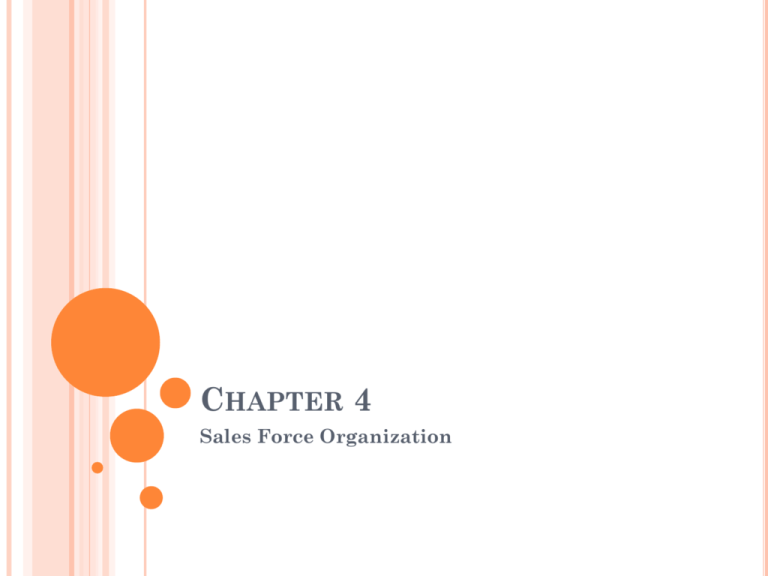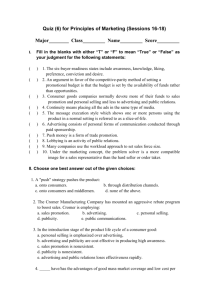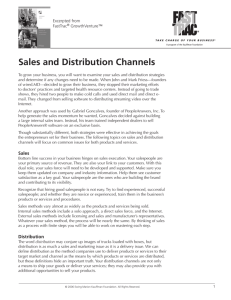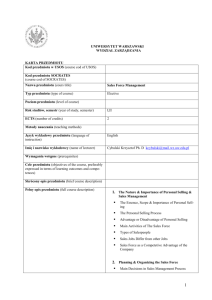Chapter 4 Sales Force Organization
advertisement

CHAPTER 4 Sales Force Organization LEARNING OBJECTIVES Sales force organization and planning Characteristics of a good organization Basic Types of organization Organizational options in the 2000s INTRODUCTION Nature of sales organization What business are we in? Objectives –strategies - tactics An organization – an arrangement of a working structure of activities involving a group of people. Organizational structures changes, why? Constantly evaluating business and making adjustments. PRINCIPLES OF ORGANIZATION DESIGN Organizational structure should reflect a marketing orientation – focus on market and customer. Organization should be built around activities, not around people – skills and knowledge Responsibility and authority should be related properly –clear responsibility and authority delegated. Span of executive control should be reasonable – recent trend broader spans of control. Organization should be stable but not flexible – firm but flexible enough. Activities should be balanced and coordinated – sales & advertising : sales reps can inform about effective advertisements to retailers. BASIC TYPES OF ORGANIZATION A line organization- simplest form. Used in very small firms or within a small department A line-and-staff organization – a line organization and staff assistants A functional organization – a step beyond; each activity specialist has line authority over the activity in relations with sales force A horizontal organization – eliminates both management levels and dept. boundaries. A small group of senior exec. oversee the support functions. (Figure 4-2) LINE-AND-STAFF SALES ORGANIZATION Chief Marketing Executive Advertising Manager Marketing Research Manager General Sales Manager Sales Promotion Manager Sales Analysis Manager Salespeople Line authority Staff advisory authority LINE-AND-STAFF SALES ORGANIZATION The most widely used basic form or organization in sales departments. Appropriate when: Sales force is large Market is regional or national Line of products is varied. Number of customers is large. Benefits and disadvantages: Division of labor and exec. specialization. Total cost of organization can be high, especially when staff assistants have their own depts. (Figure 4-3) FUNCTIONAL SALES ORGANIZATION Chief Marketing Executive Advertising Manager Marketing Research Manager General Sales Manager Credit Manager Sales Promotion Manager Salespeople Line authority Staff advisory authority FUNCTIONAL SALES ORGANIZATION Used in large company with variety of product line and/or markets. A functional exec. has line authority to order the assistant sales manager and the sales people to do the job. Benefits and disadvantages. The more giving orders, the more trouble. Specialization of labor and assurances that functional exec. plans and programs will be carried out. (Figure 4-4) THE HORIZONTAL CORPORATION Manufacturing Team Product Design and Development Team Systems Engineering Production Quality Control Customer Research Customer Analysis Design Engineering Strategic Planning Team VP Strategic Planning VP Finance & Information Chief Operating Officer Human Resources Administration Customer Support Team Information Training Service Research Customer Fulfillment Team Pricing and Promotion Sales Distribution THE HORIZONTAL CORPORATION A small group of senor exec. at the top oversee the support functions. Everyone else is a member of crossfunctional teams that perform core processes. These teams are self-managed. Used by large and small companies seeking greater efficiencies and customer responsiveness. Benefits and disadvantages Various cross-functional teams work with customers’ teams to solve problems and create opportunities for greater productivity and growth. Reduces supervision and eliminates activities that are not necessary for the process. Costs reduces and customer responsiveness is enhanced. (Figure 4-5) GEOGRAPHICAL SALES ORGANIZATION Chief Marketing Executive Advertising Manager Marketing Research Manager General Sales Manager Sales Promotion Manager Western Regional Sales Manager Eastern Regional Sales Manager 4 District Sales Managers 4 District Sales Managers Salespeople each with own territory Salespeople each with own territory Sales Analyst (Figure 4-6) SALES ORGANIZATION WITH PRODUCTSPECIALIZED SALES FORCE Chief Marketing Executive Advertising Manager Marketing Research Manager General Sales Manager Sales Promotion Manager Sales Manager Product A Sales Manager Product B Sales Manager Product C Salespeople Product A Salespeople Product B Salespeople Product C Customer Relations Manager (Figure 4-7) SALES ORGANIZATION WITH PRODUCT MANAGERS AS STAFF SPECIALISTS Chief Marketing Executive Advertising Manager Marketing Research Manager General Sales Manager Assistant Sales Manager Salespeople Manager Manager Manager Product Product Product A B C PRODUCT SPECIALIZATION Used when: A variety of complex, technical products Very dissimilar, unrelated products – a rubber company may use three sales force to sell; a track and tires, rubber footwear, industrial rubber products. (Figure 4-8) SALES ORGANIZATION SPECIALIZED BY TYPE OF CUSTOMER Chief Marketing Executive Advertising Manager Marketing Research Manager General Sales Manager Sales Promotion Manager Customer Relations Manager Sales Manager Transportation Industry Sales Manager Steel Industry Sales Manager Petroleum Industry Salespeople Salespeople Salespeople (Figure 4-9) ORGANIZATIONAL OPTIONS FOR THE 2000S Strategic account management Independent reps Organizational Options for the 2000s Team selling E-commerce and telemarketing STRATEGIC ACCOUNT MANAGEMENT (SAM) Also known as global account management (GAM). Companies developed separate structure to deal with major accounts. Three commonly used approaches are: Creating a separate sales force Using executives Creating a separate division TEAM SELLING A selling team is a group of people representing the sales department and other functional areas such as finance, production, and research and development (R&D). THE RELATIONSHIP BETWEEN A SALES TEAM AND A BUYING CENTER Organizational selling center Marketing Sales Manufacturing Salesperson Exchange Process Purchasing Agent Information Organizational buying center Purchasing Problem Solving Negotiation Manufacturing R&D Friendship, Trust R&D Engineering Product/Services Payment Engineering Physical Distribution Reciprocity Marketing INDEPENDENT SALES ORGANIZATIONS Manufacturer’s representative or manufacturer’s agent. Most of used in the following situations: When a manufacturer does not have a sales force. When a producer wants to introduce a new product but does not want to use existing sales force. When a company wants to enter a new market that is not sufficiently developed for the seller to use its own sales force. when it is not cost-effective for a company to use its own reps because the sales potential does not justify the cost. USES OF TELEMARKETING AND ECOMMERCE Identify prospective customers Screening, qualifying leads Sales solicitation: small customers, re-orders Order processing Product service support Account management and reporting Customer relations







